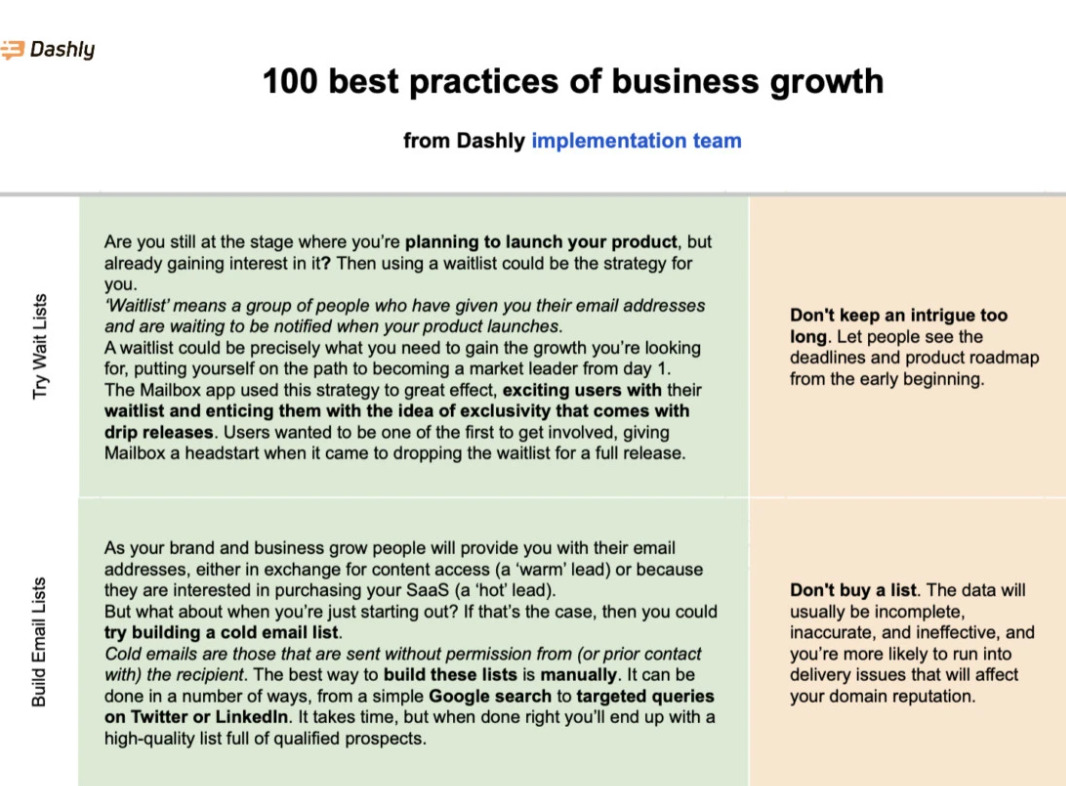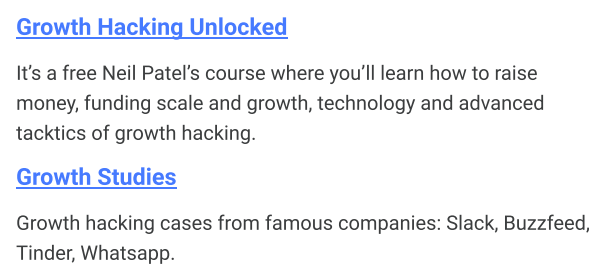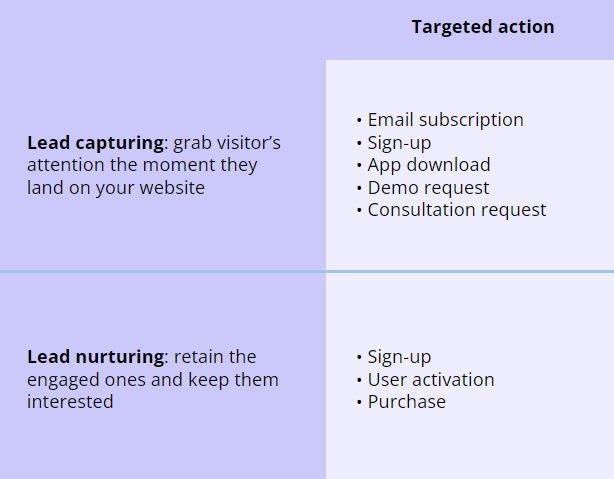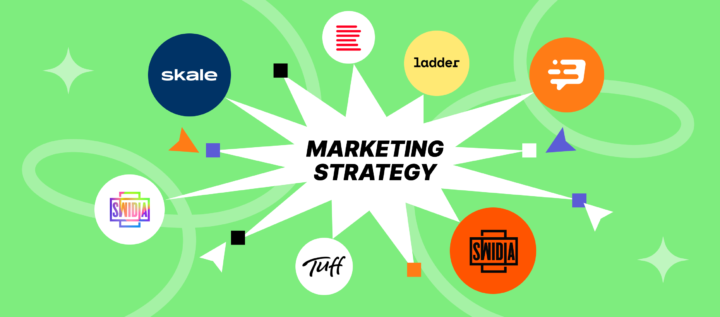What is growth hacking and how it works [explained by experts]
![What is growth hacking and how it works [explained by experts]](https://www.dashly.io/blog/wp-content/uploads/2023/04/What-is-growth-hacking-and-how-it-works-explained-by-experts-1440x634.png)
Are you tired of hearing about growth hacking but still have no clue what does it actually mean? Don’t worry, you’re not alone! But, hold on tight because you’re about to get a crash course in the exciting world of growth hacking.
Just look at these impressive stats: companies that have implemented marketing growth strategy have seen an average customer led growth rate of 30-50% per month! That’s right, you read that correctly — per month!
And the best part? These results can be achieved with limited resources and budget.
So, if you’re ready to join the ranks of successful companies like Airbnb, Dropbox, and Uber, who all credit Growth Hacking for their meteoric rise, you need to keep reading.
This post will give you a comprehensive understanding of what growth hacking is, its benefits, and what a growth expert does.
Test growth hypotheses quickly and without developers with Dashly

Let’s get started with the growth hacking definition.
Growth hacking. What is it?
It’s like the magic potion for businesses, a mix of marketing, user information, and engineering to help them grow faster than Jack’s beanstalk!
Growth hacking meaning, in a nutshell, is a marketing tactic that focuses on finding innovative, data-driven, and often low-cost strategies to acquire, engage, and retain customers. It’s like a Jedi mind trick, but for business success!
Thinking about the growth hacking definition, picture this: you’re running a business selling hats for cats. Now, everyone loves a cat in a hat, right? But how do you reach all those potential feline fashionistas without breaking the bank?
That’s where growth hacking comes in.
You could create a viral social media campaign where people share pictures of their fabulous hat-wearing cats with a unique hashtag. You could offer a small discount for every post on their next hat purchase. It’s a win-win: your customers get a deal, and you get free marketing with lots of cute cat pictures! Who wouldn’t want to be a part of that, right?
Let’s consider one of the real-life growth hacking examples.
Remember Dropbox? They offered extra storage space for users who referred their friends to sign up. This tactic was so successful that they increased their user base from 100,000 to 4 million in just 15 months! Now that’s what I call a “drop” in the bucket!
So, if you want your business to shoot up like a rocket, it’s time to start exploring those innovative strategies!
Read also: 25 Growth Marketing Books to Skyrocket Success
Growth hacking benefits for your business
Growth marketing has taken the business world by storm, and for good reason. Here are just a few of the benefits:
1️⃣ Increased customer acquisition — Companies that have adopted growth hacking have seen a 50-100% increase in customer acquisition within just a few months!
2️⃣ Improved customer engagement — growth hacking also helps businesses improve customer engagement, leading to higher customer retention rates and more repeat business.
3️⃣ Faster growth — The whole point of growth hacking is to achieve rapid success. Companies that have adopted Growth Hacking have seen an average growth rate of 30-50% per month!
Growth hacking can help businesses achieve rapid growth with limited resources and budget.
4️⃣ Cost-effective — With SaaS growth hacks, businesses can achieve impressive product metrics framework KPIs with limited resources and budget.
5️⃣ Data-driven approach — Monitor data and growth marketing analytics to drive sales, leads, users, etc. This means businesses can make informed decisions based on hard data, rather than just gut instincts.
Growth hacking is a data-driven approach to growth that helps startups quickly identify and test new opportunities.
So, what are you waiting for? Start harnessing the power of growth hacking and watch your business soar!
Thanks! Here’s your copy of 100 growth ideas

Growth hacking vs. traditional marketing
Growth hacking and traditional marketing might seem similar at first glance, but they are quite different approaches to growing a business. While digital marketing focuses on tried-and-true methods, growth hacking is about creativity and thinking outside the box. And it’s true for both B2C and B2B growth marketing.
Let’s take a closer look at the differences between growth hacking and traditional marketing:
- Speed — Growth hacking is about achieving rapid growth, while traditional marketing focuses on steady and consistent growth over time.
Neil Patel, a digital marketing expert, argues that growth hacking is a short-term solution for startups looking for rapid growth, but traditional marketing is a better long-term strategy. He believes that the last one is essential for building brand awareness and establishing a strong customer base
- Budget — Marketing often requires a large budget for advertising and marketing campaigns, while growth hacking can be done with limited resources.
- Data-driven — Growth hacking relies heavily on data and analytics to drive growth, while usualmarketing often relies on intuition and experience.
- Creativity — Growth hacking is all about being creative and thinking outside the box, while traditional one sticks to tried-and-true methods.
Examples:
Airbnb is a prime example of a company that successfully used growth hacking to scale its business. They used creative growth marketing tips like cross-promoting with Craigslist to reach a wider audience and drive sales, leads, users.
On the other hand, Coca-Cola is a classic example of a company that has relied on traditional marketing for growth. Their iconic advertising campaigns, such as the “Share a Coke” campaign, are a prime example of ordinary marketing at its best.
So, which approach is better? It really depends on your business and its goals. Growth hacking is a great option for startups and businesses looking for rapid success, while traditional one is a better fit for established businesses looking for steady and consistent improvement.
Brian Balfour, CEO of Reforge, a growth marketing consultancy, says that growth hacking and traditional marketing are not mutually exclusive. He believes that businesses can achieve the best results by combining the two approaches and using each to complement the other.
How does growth hacking work?
Think of growth hacking like a chef trying out new recipes in the kitchen. The chef starts by gathering ingredients, experimenting with new flavors, and testing the results for your SaaS startup ideas. If the dish turns out well, the chef scales up the recipe and serves it to the restaurant customers. And the cycle continues, with the chef always experimenting and trying new things in the kitchen.
Growth hacking works similarly. It starts with identifying business fields to improve, experimenting and running growth marketing tests, and scaling up the successful ones. And the process never stops, as growth hackers are always looking for new and creative ways to drive growth.
If you need more inspo for your experiments, check out our growth marketing playbook!
In a nutshell, growth hacking is a continuous process of:
- Identifying growth opportunities — This involves analyzing information, researching the market, and looking for new and creative ways to reach customers.
- Experimenting and testing – This involves testing some small-scale growth hypothesis to see what works and what doesn’t.
- Implementing and scaling — If a growth opportunity proves successful, the next step is implementing it on a larger scale. This involves fine-tuning the strategy, making necessary changes, and scaling up the implementation.
- Continuous iteration — Growth hacking is not a one-time process. It’s an ongoing journey. The key to success is continuously experimenting, testing, and iterating to improve the key growth marketing metrics.
So, get ready to put on your detective hat and start hacking your way to success!
Launch growth experiment to raise conversion on your website without developers

What is a growth hacking expert?
Have you ever heard the term “growth hacker” and wondered what it means? Well, wonder no more! This expert is a hybrid of a marketer and a data-analyst, with a dash of creativity for good measure.

Think of a growth hacker as a superhero job, using their powers of innovation and data analysis to help businesses achieve rapid increase in leads, sales, etc. They’re the ones who come up with creative and unconventional strategies to reach customers, drive engagement, and increase sales.
Some examples of successful growth hackers include Sean Ellis, who is credited with coining the term “growth hacking”, and Aaron Ginn, who worked for StumbleUpon and Tinder. These hackers have used their skills to help companies like Dropbox and Airbnb achieve massive success.
Expert view on the meaning of growth hacker’s job:
A Growth hacker is an individual whose true north is growth. They are constantly experimenting and testing new strategies to drive growth for their company. They are data-driven, creative, and think outside the box to find new and innovative ways to reach customers and increase engagement. They are constantly iterating on their tactics to achieve rapid and sustainable growth for their business.
Read also: Your Growth Marketing Strategy Template with guide and examples
So, what does growth experts actually do?
They’re responsible for identifying new opportunities, experimenting and testing new B2C or B2B growth marketing strategies, and continuously iterating on their tactics to drive sales, leads number, etc. They’re the ones who come up with clever and innovative ideas that help businesses reach new customers and drive engagement.
In short, this experts is a combination of marketer, analyst, and creative problem-solver, all rolled into one.
If you want to take your business to the next level, it’s time to start considering hiring a growth hacker! They might be the superhero your business needs to achieve rapid improvement.
Launch growth experiment to raise conversion on your website without developers

A short list of famous growth hackers that you should follow

Sean Ellis
As the person who coined the term “growth hacking,” Sean Ellis is a pioneer in the growth marketing field. He has helped companies like Dropbox, LogMeIn, and Eventbrite achieve rapid growth.

Andrew Chen
A well-known marketer and investor, has worked with companies like Uber, AngelList, and Tinder. His blog covers a wide range of growth marketing topics and strategies.

Neil Patel
A successful entrepreneur and digital marketer, Neil Patel co-founded Crazy Egg, Hello Bar, and KISSmetrics. His blog and podcast offer valuable insights on growth marketing, SEO, and content marketing.

Brian Balfour
As the former VP of Growth at HubSpot (one of the popular growth marketing tools), Brian Balfour is a growth marketing expert with extensive experience. He is the founder of Reforge, an online platform offering growth marketing courses for professionals.

Hiten Shah
Co-founder of KISSmetrics, Crazy Egg, and FYI, Hiten Shah is a seasoned entrepreneur with a wealth of experience in growth marketing. He shares valuable insights through his blog, podcast, and speaking engagements.
These growth hackers are at the forefront of the growth hacking movement and are a wealth of information and inspiration for anyone looking to drive rapid improvement for their business. So, follow them today and get ready to hack your way to success!
Thanks! Here’s your list of must-read books on growth hacking

Growth Hacking Examples
Here are some examples of famous brands that have used growth hacking techniques to grow their business:
- Airbnb — Instead of spending millions on advertising, Airbnb used a clever marketing hack by leveraging Craigslist, which already had a large audience in their target market. By creating an integration that allowed Airbnb listings to be cross-posted to Craigslist, Airbnb was able to tap into a much larger pool of potential users.
This simple hack was responsible for a large part of the company early scale and helped them become the giant they are today. - Dropbox — Dropbox’s file storage and management tool has a double-sided referral program. It is a classic example of a growth hacking technique in action. By offering users free additional storage space for each friend they referred to this platform via email, they were able to incentivize users to spread the word and share their product, resulting in 60%+ growth in their user base and sales within just a few months.
- Instagram — Instagram’s early growth was driven by a simple yet highly effective viral loop. Whenever a user shared a photo on Instagram, it was automatically posted to their Facebook newsfeed. This allowed Instagram to tap into Facebook’s massive audience and quickly grow its own user base.
This powerful growth hack helped Instagram’s users base skyrocket to over 1 billion users and eventually led to its acquisition by Facebook. - Uber — Uber’s initial growth was driven by word of mouth and incentivized referral programs. By offering free rides to users who referred their friends, the company was able to tap into the power of social proof and create a loyal community of brand advocates.
This resulted in rapid growth and helped Uber become the behemoth it is today, valued at $72 billion as of 2018. - Slack is one of the fastest-growing communication platforms. One example of their growth hacking strategy is their famous “Invite Friends and Teams” feature. They implemented a simple and straightforward referral program that allowed users to invite friends and team members to the platform. When a user invites others, they would receive an additional feature or an upgrade to their account. This approach not only helped incentivize users to invite others, but it also improved theyr digital experience and skyrocket this tool’s growth in terms of users virally.
These are just a few examples of how growth hacking techniques have been used by famous brands to achieve massive growth and success. Each of these techniques was simple yet highly effective in driving growth and engaging users.
To sum up: How to start growth hacking
Starting growth hacking can seem overwhelming, but anyone can get started with some guidance. Here’s a quick summary:
- Get familiar with the basics — Start by learning the basics of growth hacking, including what it is, how it works, and what a growth hacker does. Read books, articles, and blog posts to understand the subject comprehensively.
- Analyze your data — Growth hacking is a data-driven marketing approach, so it’s important to understand your business data well. Analyze users info including demographics, behavior patterns, and pain points.
- Identify growth opportunities — Look for new and creative ways to reach customers, increase engagement. Analyse your users info to identify potential perspectives and experiment with new strategies. To systematize this process, create a growth hacking canvas.
- Experiment and test — Growth hacking is about experimenting and testing new strategies. Start by creating small-scale tests to see what works and what doesn’t. Use analytics to measure your results and make informed decisions.
- Implement and scale — If a strategy proves successful, scale it up and implement it on a larger scale. Continuously iterate and improve your strategies to drive even more improvement.
In conclusion, growth hacking is a data-driven, iterative process that involves experimenting, testing, and scaling new perspectives. With guidance and creativity, anyone can start growth hacking and achieve rapid improvement for their business.
Thanks! Here’s your copy of the growth strategy template

FAQ on growth hacking
The definition of the growth hacking marketing?
The answer to What is growth hacking refers to using creative and unconventional strategies to rapidly grow a business or product in a short amount of time. It involves leveraging data, technology, and experimentation to identify and exploit company development opportunities, focusing on measurable results and ROI.
Growth hacking often involves a combination of marketing, product development, and customer acquisition techniques to drive user adoption and retention, increase revenue, and achieve rapid growth.
What is the goal of growth hacking
Whats the point of growth hacking activities? — Rapid business growth. The goal of growth hacking is to rapidly scale a business or product by identifying and exploiting opportunities for growth cost-effectively. Growth hackers focus on finding innovative and unconventional ways to acquire new customers, retain existing ones, and increase revenue, focusing on measurable results and ROI.
The ultimate goal of growth hacking is to achieve exponential growth and establish a sustainable competitive advantage in the marketplace.
Unlike usual marketing, which focuses on long-term brand building and awareness, growth hacking is all about achieving rapid and sustainable growth through experimentation, analysis, and agile product development.
What is growth hacking in digital marketing?
Hacking growth in digital marketing refers to using data-driven experimentation and unconventional techniques to achieve rapid and sustainable growth. A growth marketing team uses a variety of tactics, such as A/B testing, referral marketing, social media campaigns, and SEO, to acquire and retain customers, increase revenue, and establish a competitive advantage in the marketplace.
The key factor here is focusing on measurable results and ROI, using data and analytics to guide decision-making and optimize campaigns.
By leveraging the power of digital technology and the internet, growth hacking allows businesses to achieve unprecedented success and scale quickly, effectively “hacking” the growth process.
What is growth hack?
A growth hack is a creative and unconventional technique or strategy to achieve rapid and sustainable development in a business or product. Growth hacks often involve leveraging technology and data to identify and exploit opportunities, focusing on measurable results and ROI.
To understand the growth hack definition consider Dropbox’s referral program as an example. They offered users extra storage space in exchange for inviting their friends to use the platform.
This simple but effective tactic allowed Dropbox to rapidly acquire new users and achieve exponential success without spending much money on advertising.
Growth hacking terms
- CRO — The process of optimizing a website or landing page to increase the percentage of visitors who take a desired action, such as purchasing or filling out a form.
- Referral marketing — A marketing strategy incentivizes existing customers to refer new customers to a business or product.
- Social media marketing — A form of marketing that uses social media platforms like Facebook, Instagram, and Twitter to reach and engage with customers.
- SEO — Optimizing a website or content to rank higher in search engine results pages (SERPs), increasing organic traffic and visibility.
- A self-sustaining customer acquisition and retention cycle that leads to exponential growth.
- Minimum viable product (MVP) — A basic version of a product that is launched quickly and with minimal features to test the market and gather feedback.
- Churn rate — The percentage of customers who stop using a product or service over a given time.
What does growth hacking manager mean?
Who is growth hacker? It is a professional specializing in using creative and unconventional strategies to achieve rapid and sustainable development in a business or product.
Growth hackers typically have a strong understanding of data analytics, technology, and marketing and use a variety of tactics such as A/B testing, viral marketing, referral marketing, and social media campaigns to acquire and retain customers, increase revenue, and establish a competitive advantage in the marketplace.
The goal of a growth hacker is to achieve exponential development and scalability, often using a lean and agile approach that focuses on measurable results and ROI.
So, what does a growth expert actually do?
They’re like a detective, constantly analyzing data, researching the market, and hunting down new opportunities. They’re not afraid to try new things and always experiment and test new strategies.
And when they find an idea that works, they don’t just sit back and relax. They continuously iterate and improve, always looking for ways to make their strategies even more effective. So if you want to find a growth hacker for your startup, look for a curious person who knows how to work with data and isn’t afraid of making mistakes.
What are the best hacking tips people practice in 2023?
- Know your target audience: Understanding your audience is crucial to creating a strategy that will resonate with them. You need to know their needs, interests, and pain points so you can craft the right message and offer the right solutions.
- Focus on one metric that matters: Don’t get bogged down in trying to track multiple metrics at once — instead, focus on one key metric that truly matters to your business. This will simplify your workflow and help you optimize for the results you want to see.
- Use social proof to your advantage: People are more likely to trust and try something if they see others using and enjoying it. Use social proof to showcase positive reviews, customer feedback, or even user-generated content to build trust and credibility with your audience.
- Tap into the power of email marketing: Email marketing is still one of the most effective ways to reach your audience and drive conversions. Use email to nurture leads, make special offers, and keep your audience engaged with your brand.
- Leverage the latest technology: Keep up to date with the latest growth marketing services and technologies that can help you streamline your efforts, improve your targeting, and track your progress more effectively.
- Experiment, test, and optimize: Don’t be afraid to take risks and try new things to see what works and what doesn’t. Continuously test and optimize your strategies to find the most effective way to grow your business.
What are content growth hacks?
Some of the last innovative content growth hacks include:
- using interactive content such as quizzes and polls,
- creating personalized content for specific audience segments,
- leveraging user-generated content like customer stories on the Instagram,
- and incorporating video content into your strategy.
Additionally, using chatbots and AI-powered recommendations can help increase engagement and drive growth via content marketing.
Read also:
- Growth marketing vs performance marketing: What to choose for your business?
- Growth marketing newsletter: 18 expert digests for regular insights
- RevOps vs Sales Ops: Know the difference
- Growth marketing case studies: 12 stories with detailed tactics and numbers achieved
- RevOps best practices: 13 tactics to implement this year
- Top 10 product led growth software your competitors use in 2023
- 10 product led growth companies that boost their development right now
- Growth marketing framework: Battle-tested insights from Dashly experts
- Growth Product Manager: Charting new frontiers in product scaling
- 20 product led growth examples to inspire your team [expert edition]

![13 growth hacking examples tested by Dashly experts [+46 free templates]](https://www.dashly.io/blog/wp-content/uploads/2023/05/Growth-hacking-examples-to-inspire-your-team-720x317.png)




![25 growth hacking books [recommended by Dashly growth hackers]](https://www.dashly.io/blog/wp-content/uploads/2023/05/Growth-Hacking-Books-720x317.png)





